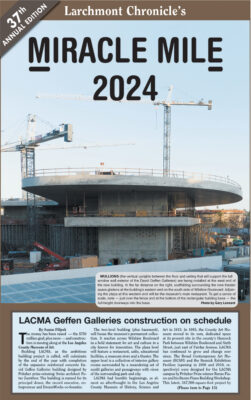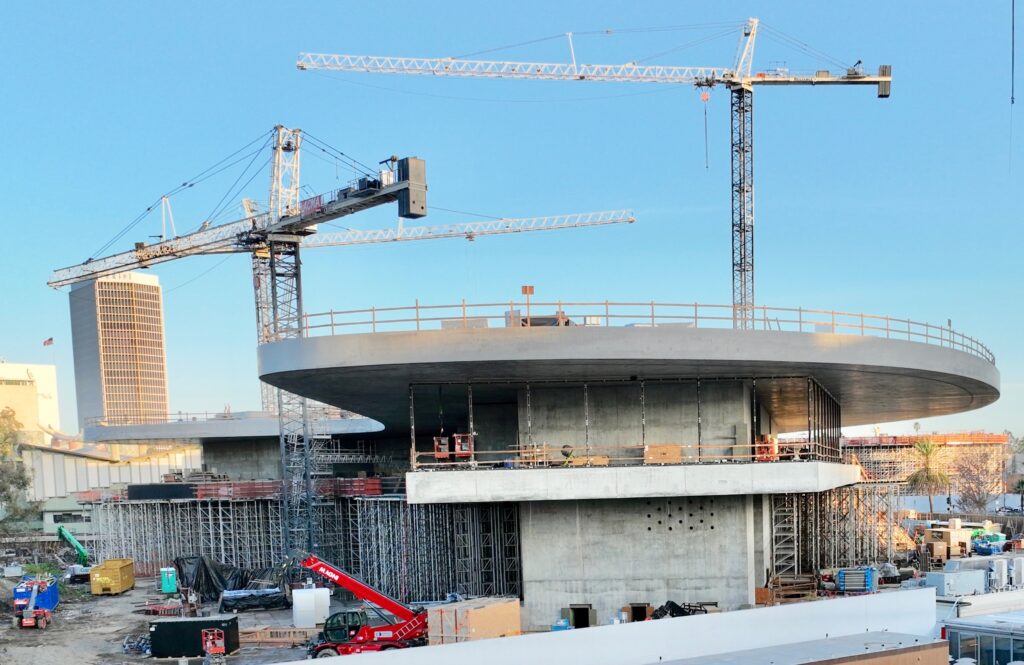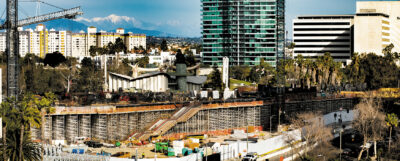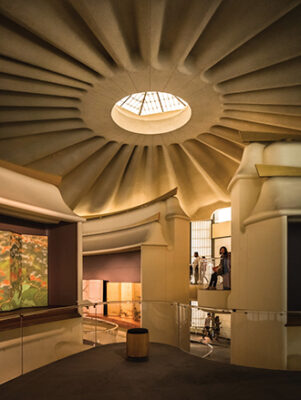LACMA Geffen Galleries construction on schedule
 The money has been raised — the $750 million goal, plus more — and construction is moving along at the Los Angeles County Museum of Art.
The money has been raised — the $750 million goal, plus more — and construction is moving along at the Los Angeles County Museum of Art.
Building LACMA, as the ambitious building project is called, will culminate by the end of the year with completion of the expansive reinforced concrete David Geffen Galleries building designed by Pritzker prize-winning Swiss architect Peter Zumthor. The building is named for its principal donor, the record executive, entrepreneur and DreamWorks co-founder.
The two-level building (plus basement), will house the museum’s permanent collection. It reaches across Wilshire Boulevard in a bold statement for art and culture in a city known for innovation. The plaza level will feature a restaurant, cafés, educational facilities, a museum store and a theater. The upper level is a collection of interior gallery rooms surrounded by a meandering set of sunlit galleries and passageways with views of the surrounding park and city.
LACMA had humble beginnings, as almost an afterthought in the Los Angeles County Museum of History, Science and Art in 1913. In 1965, the County Art Museum moved to its own, dedicated space at its present site in the county’s Hancock Park between Wilshire Boulevard and Sixth Street, just east of Fairfax Avenue. LACMA has continued to grow and change ever since. The Broad Contemporary Art Museum (BCAM) and the Resnick Exhibition Pavilion (opening in 2008 and 2010, respectively) were designed for the LACMA campus by Pritzker Prize winner Renzo Piano and his Renzo Piano Building Workshop. This latest, 347,500-square-foot project by Zumthor, with Skidmore Owings & Merrill (SOM) as executive architects, commenced excavation in 2020. The new structure slowly is emerging as its scaffolding and falsework are gradually being removed, moving from west to east.

MULLIONS are being installed. Photo by Gary Leonard

LACMA UNDER CONSTRUCTION this month (above) and one year ago (below) shows real progress. Today, floors and ceilings have been poured for all the galleries, and insulation (white material) is being staged on the roof. One year ago, the only thing visible was the scaffolding holding up the falsework in preparation for pouring the ceiling above the open areas on the ground. The Pavilion for Japanese Art, visible in the bottom photo, will be visually and physically accessible below the new galleries. Note the main entrance stairway in both photos. Photos by Bill Devlin

Museum officials promise the finished museum will bring a fresh take on a big art museum that will exude openness, accessibility and equity for all.

INTERIOR of the Pavilion for Japanese Art, circa 2007.
By sometime next year, after installation of LACMA’s art collection, Angelenos and visitors will be able to see and decide for themselves.
The two county facilities, the Museum of Art and the Tar Pits of the Natural History Museum, take up a substantial portion of the park. However, with the new Geffen Galleries building, there will a greater “park-like” feel and sense of ground-level openness. With the exhibition level high above ground, the plaza-level spaces between the giant pedestals holding up the building (all atop giant earthquake-addressing base isolators), there will be clear views to the Page Museum at the La Brea Tar Pits, to the verdant bowers under the mature trees of Hancock Park and to the Pavilion for Japanese Art designed by Bruce Goff and opened in 1988. Former Larchmont Chronicle columnist Paula Panich wrote about that pavilion (“‘Art is the Client:’ LACMA, the wrecking ball, and surviving jewel box”) in the April 2020 issue.
Category: Real Estate
